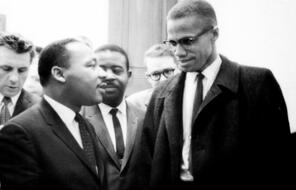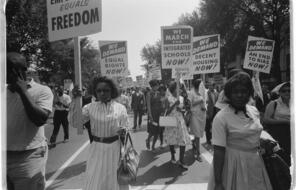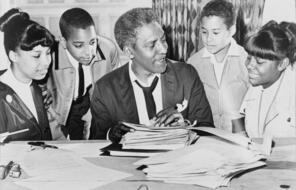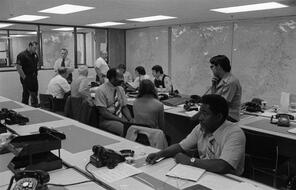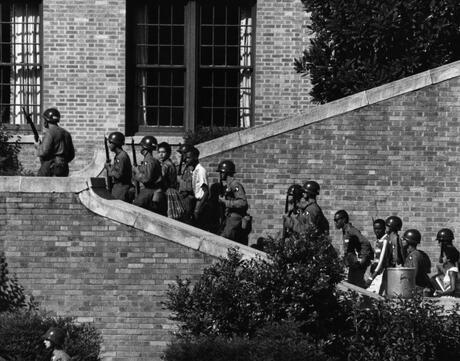
Remembering Little Rock
The desegregation of Central High School in Little Rock, Arkansas exactly sixty-four years ago this weekend remains a flashpoint in American history, the history of the Civil Rights Movement, and the history of education in the United States. Following the Brown v. Board decision of 1954 which rendered racial segregation of schools unconstitutional, the NAACP devised a plan to desegregate Central High School as a test case within the new legal environment created by the Brown decision. A group of nine Black students were selected to integrate the school and, upon their arrival, faced immense violent opposition from white mobs and armed forces deployed by Arkansas’ governor. Historian Taylor Branch described the event as “the most severe test of the Constitution since the Civil War” and the level of conflict it engendered seems to lend further credence to this comparison.
It was on September 3rd that Arkansas Governor Orval Faubus enlisted the National Guard to prevent the nine Black students from entering the school as armed white civilian mobs also stood by, threatening the children. Following a number of failed attempts at negotiation with Faubus, U.S. President Dwight D. Eisenhower would ultimately seize control of Arkansas’ National Guard through Executive Order 10730 which subsequently ordered the Guard to oversee, rather than prevent, the integration and protect the nine Black students. In addition, Eisenhower deployed federal troops to the scene by air at the urgent request of Little Rock Mayor Woodrow Wilson Mann. On September 25, 1957, the nine students—by then known as the Little Rock Nine—would successfully enter the school building. Supported by their mentor Daisy Bates, the Little Rock Nine would complete the academic year at the school despite being subjected to constant racist violence and bullying.
The history of the desegregation of Central High School is replete with lessons for our times and an exemplary case study for young people exploring themes of civic agency as they learn American history. Facing History’s multimedia curriculum Choices in Little Rock focuses on efforts to desegregate Central High School with an emphasis on the decisions people—including young people—make as citizens in a democracy. The unit is designed to promote students’ historical understanding, critical thinking, social-emotional learning, and civic agency.
Our multimedia resource collection contains the following:
Teacher Resources
- Choices in Little Rock case study
- Unit Outline for Teachers
- Common Core Writing Prompts and Strategies
Student Resources
- Choices in Little Rock Student Guide (includes English and Spanish versions)
- Journal
Video Content
This collection also includes a rich array of videos featuring various witnesses to this history as well as contemporary events that help students connect their own lives in the present to the past.
A key example is this video with Little Rock Nine member Terrence Roberts in which he addresses the importance of understanding the history of segregation and civil rights to combat racism and discrimination today.
We invite educators to use our featured collection "Teaching Choices in Little Rock" to address this important history in the classroom.
Access Resources
Don't miss out!
- download classroom materials
- view on-demand professional learning
- and more...

